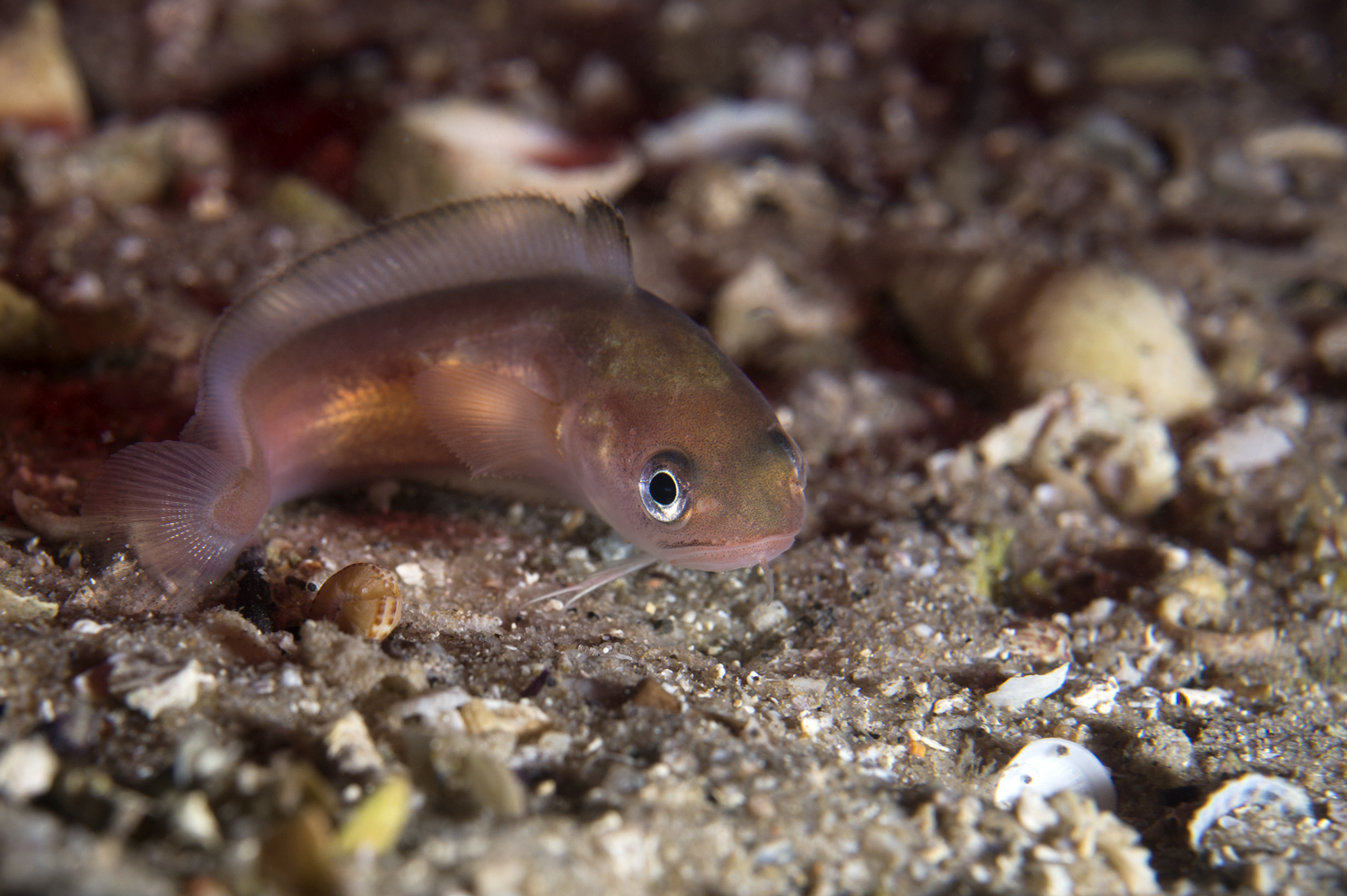- Classification
- ACTINOPTERYGII
- GADIFORMES
- MORIDAE
- Pseudophycis
- breviuscula
Bastard Red Cod, Pseudophycis breviuscula (Richardson 1846)
Other Names: Fork Beard, Northern Bastard Codling, Northern Bastard Red Cod

A Bastard Red Cod, Pseudophycis breviuscula, in the harbour at Gabo Island, eastern Victoria, November 2016. Source: Julian K. Finn / Museums Victoria. License: CC BY Attribution-NonCommercial
Summary:
A pale reddish-brown cod becoming paler below, with a faint dark line along the upper jaw, a narrow black margin on the dorsal and anal fins, a broad black margin on the caudal fin, and the pectoral and pelvic fins and chin barbel mostly whitish.
Cite this page as:
Bray, D.J. 2021, Pseudophycis breviuscula in Fishes of Australia, accessed 27 Jun 2025, https://fishesofaustralia.net.au/Home/species/2855
Bastard Red Cod, Pseudophycis breviuscula (Richardson 1846)
More Info
|
Distribution |
Off North Stradbroke Island, southern Queensland, to off Rottnest Island, Western Australia, including Tasmania. The species also occurs in the Tasman Sea north of Lord Howe Island, and in New Zealand. Inhabits sandy to rocky coastal areas at depths of 4-200 m. |
|
Features |
Dorsal fin 8–11 + 42–60; Anal fn 46–68; Caudal fin 24; Pectoral fin 19–27; Pelvic fin 5–6; Vertebrae 42–46; Pyloric caecae 6-8; Oblique scale rows intersecting lateral line 80-87; Scales between dorsal-fin origin and lateral line 7-9. Body of moderate depth (21-25% SL) and length, rather thick; caudal peduncle very slender. Head moderately small (24-32% SL), nearly circular in cross section, slightly depressed anteriorly; eyes of moderate size (23-30% HL); interorbital of moderate breadth (20-28% HL); mouth moderately large (upper jaw length 47-55% HL), nearly horizontal, tip of maxilla reaching just past eye; snout protruding slightly in advance of lower jaw; teeth uniformly small, pointed, band in each jaw; chin with prominent barbel, length approximately equal to eye diameter. Scales tiny, cycloid, covering body and head, extending well onto bases of unpaired fins; lateral line smoothly curved with flexure above pectoral fin, pores in naked strip not related to adjacent scales. Anus immediately before anal fin. Two separate dorsal fins, first with short base, second very elongate, of rather uniform height; anal fin similar to second dorsal; caudal fin rounded. Pelvic fins arising below point midway between eye and rear edge of preopercle, reaching about to anus. |
|
Fisheries |
Although Bastard Red Cod are fairly common at depths of 30–60 m, it is a small species, and not considered commercially important. |
|
Similar Species |
In Australian waters, this species is often confused with the Red Cod. The Bastard Red Cod differs in being reddish-brown (vs greyish-pink) above, in having a broad black margin on the caudal fin, differing in scale counts, and lacking a dark spot at the pectoral-fin base. |
|
Etymology |
The specific name is from the Latin breviuscula (= rather short), in reference to the relatively small size of this species - described as a 'small ling'. |
|
Species Citation |
Lota breviuscula Richardson 1846, Zool. Voy. Erebus and Terror, Fish: 61, pl. 38, fig. 1, Type locality: Bay of Islands, New Zealand. |
|
Author |
Bray, D.J. 2021 |
|
Resources |
Bastard Red Cod, Pseudophycis breviuscula (Richardson 1846)
References
Cohen, D.M. 1990. Families Moridae, Muraenolepididae. pp. 346-384 in Cohen, D.M., Inada, T., Iwamoto, T. & Scialabba, N. FAO Species Catalogue. Gadiform fishes of the world (order Gadiformes). An annotated and illustrated catalogue of cods, hakes, grenadiers and other gadiform fishes known to date. FAO Fisheries Synopsis No. 125. Rome : FAO Vol. 10 442 pp.
Gomon, M.F. 1994. Families Moridae, Melanonidae, Euclichthyidae, Merlucciidae. pp. 324-340 figs 290-303 in Gomon, M.F., Glover, C.J.M. & Kuiter, R.H. (eds). The Fishes of Australia's South Coast. Adelaide : State Printer 992 pp. 810 figs.
Gomon. M.F. 2008. Family Moridae. pp. 302-315 in Gomon, M.F., Bray, D.J. & Kuiter, R.H. (eds) Fishes of Australia's Southern Coast. Sydney : Reed New Holland 928 pp.
Gomon, M.F., Struthers, C.D. & Kemp, J. 2021. A review of the Australasian genus Pseudophycis (Gadiformes: Moridae), redescribing its four species and resurrecting the name Physiculus palmatus Klunzinger, 1872, for the Australian red cod. Memoirs of Museum Victoria 80: 103-143. https://doi.org/10.24199/j.mmv.2021.80.04
Günther, A. 1862. Catalogue of the Fishes in the British Museum. Catalogue of the Acanthopterygii Pharyngognathi and Anacanthini in the collection of the British Museum. London : British Museum Vol. 4 534 pp.
Hoschke, A., Whisson, G. & Moore, G.I. 2019. Complete list of fishes from Rottnest Island. pp. 150-161 in Whisson, G. & Hoschke, A. (eds). The Rottnest Island fish book. 2nd ed. Perth : Aqua Research and Monitoring Services.
Kuiter, R.H. 1993. Coastal Fishes of South-eastern Australia. Bathurst : Crawford House Press 437 pp.
Ogilby, J.D. 1897. New genera and species of Australian fishes. Proceedings of the Linnean Society of New South Wales 22(1): 62-95. (described from Maroubra, NSW, as Austrophycis megalops) See ref at BHL
Richardson, J. 1846. Ichthyology. 53-74 pls 31-41, 43-44 & 53 (part) in Richardson, J. & Gray, J.E. (eds). The Zoology of the Voyage of H.M.S. Erebus and Terror under the Command of Captain Sir James Clark Ross, R.N., F.R.S., during the years 1839–43. London : E.W. Janson Vol. 2 139 pp. See ref online
Russell, B.C. 1983. The food and feeding habits of rocky reef fish of north-eastern New Zealand. New Zealand Journal of Marine and Freshwater Research 17(2): 121-145.
Sazonov, Y.I. 2001. Notophycis — a new fish genus of the family Moridae (Gadiformes) with description of a new species and two new subspecies and notes on the status of the genus Austrophycis. Journal of Ichthyology 41(45): 343–353.
Struthers, C.D., Gomon, M.F. & Last, P.R. 2015. 107 Family Moridae. pp. 839-866 in Roberts, C.D., Stewart, A.L. & Struthers, C.D. The Fishes of New Zealand. Wellington : Te Papa Press Vol. 3 pp. 577-1152.
Whitley, G.P. 1941. Ichthyological notes and illustrations. The Australian Zoologist 10(1): 1-50 figs 1-32 pls 1-2







